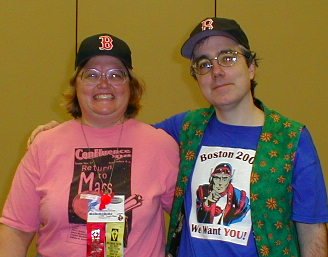Wondermakers 2 edited by Robert Hoskins
“Dominions Beyond” by Ward Moore is a wonderful alternate history of sorts. I’d previously read
More downbeat is Dean Koontz’s “The Twelfth Bed.” Koontz’s had a first career as a prolific writer of mostly mid-level, minor SF before he became a bestselling author of thrillers and horror novels (and caused most of his older work to go out of print). I’ve not read much by him, and in fact have mostly avoided him, as his works seemed like the stuff I wouldn’t care much for. But “The Twelfth Bed” is a very effective story. Humans are imprisoned by androids and forced to live out their lives in a small prison. No reason is given, nor do we know much about the world in which this is occurring. Everything, in rather Kafkaesque fashion, is focused on the room in which the prisoners live. The story describes how a small group of them react, probing a bit into how people would react in such circumstances. If more of Koontz’s earlier short stories were of this quality, we lost a promising writer when he moved into the world of bestsellers.
Wondermakers 2 also features stories by the two greatest SF satirists of the mid-fifties and sixties: William Tenn and Robert Sheckley, though both are represented by good if somewhat minor stories.
Ursula LeGuin’s “Vaster than Empires and More Slow” is set in her Hainish universe. It examines what happens to a crew of a starship – one an empath – who go on a voyage of exploration. The story centers around the reactions of the crew to the empath and the empath, who feels and responds to the emotions of all those around him, to them: crammed in amidst the emotions of the others, he hates them, and, because of how he acts on this, they hate him. It looks at the true horror of what empathy could be like for an empath. His reactions are understandable; he is constantly awash in a sea of emotion, and withdrawal is his only defense in the end. But things become worse when they land on a planet where the vegetable biomass is, if not quite sentient, able to feel, to respond, and to reflect emotion back. It’s a powerful story, a good example of earlier LeGuin. There are a few flaws – she drops into too much explanation of the empath’s condition later in the story – but despite that it’s one of the best in the collection.
Isaac Asimov’s “Living Space” is good, if minor. Like many Asimov stories, if centers on an idea, not characters, and ends with a twist on that idea. Humans have discovered a way to move into alternate dimensions. They solve the population problem by offering everyone an uninhabited earth of their own; after all, if there are infinite earths, there are infinite earths that never developed life. But if there are infinite earths, there are also ones which are doing the same thing, and more. The story is interesting enough, but with little emotional impact, memorable only for its central idea.
Poul Anderson’s “The Horn of Time the Hunter” is part of his Kith future history. A starship, moving at relativistic speeds, is returning from a many thousand year journey, and stops on a once-inhabited planet. At first they find only ruins, but then find an intelligent aquatic species. It features strong characterization as well as an penetrating look at the tricky moral situation of how one deals with someone who – perhaps through misunderstanding – has just killed a close friend. It’s the typical
“The Case of the Martian Client,” by Manly Wade Wellman and Wade Wellman, is a story about what Sherlock Holmes and Professor Challenger may have done during Wells’s Martian invasion. There’s really not much of a plot to it; its main power comes from the interactions of the characters, which the Wellmans handle quite well. It’s followed, though, by a rather strange afterward by Wade Wellman. It starts well enough, with him describing the genesis of the story. But it then descends into rather nutty speculation about why the UFOs are watching us (Wellman seems to be a believe that UFOs are real alien spacecraft) and what a bad idea it is to beam messages into space, where hostile or even hungry aliens might hear. Quite wacky.
The final story, Robert Silverberg’s “Caught in the Organ Draft,” covers some of the same territory as Niven’s “The Jigsaw Man.” In the future, in attempt to get more organs for those who need them, a draft is instituted. The draftees may need to donate a kidney or a lung. The story works well on several levels. The surface story works well, but there are also several other levels. The story comments on how drafts work (it was published in 1972 and thus written in the midst of the draft in the Vietnam war), including why some who don’t like the draft have mixed reactions, both to why they don’t like the draft as well as why they may give into anyway. It also explores the issue of a the young of a society giving up resources to the old as a society ages – something that resonates today as Social Security and Medicare spending is soaring. This is a strong Silverberg story, from his most productive period, and packs a strong impact.
There are several other minor stories, and all are at least enjoyable (except perhaps for the very short Zelazny story “The Monster and the Maiden,” which just had me scratching my head). It’s a collection worth looking for in the used books stores near you (or of course on the Web).


0 Comments:
Post a Comment
<< Home